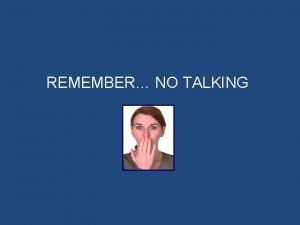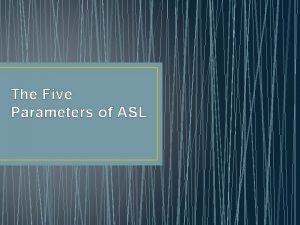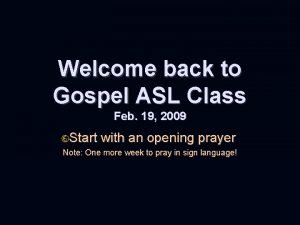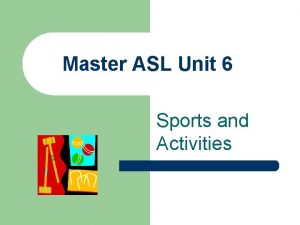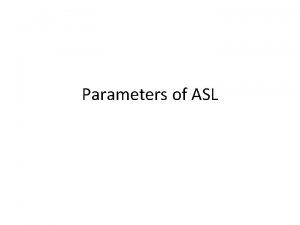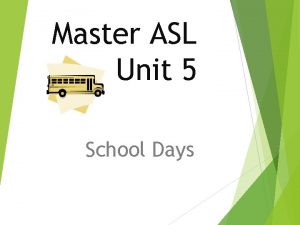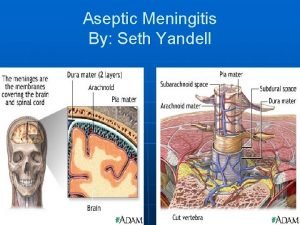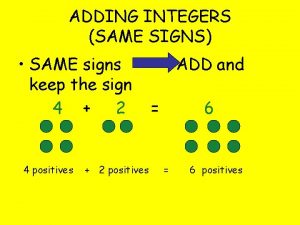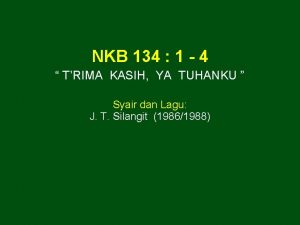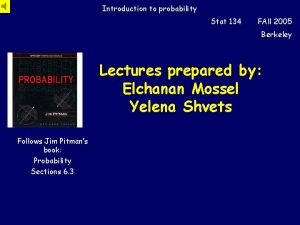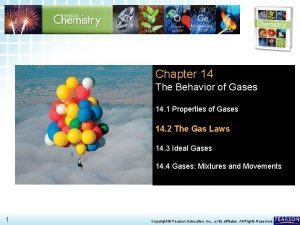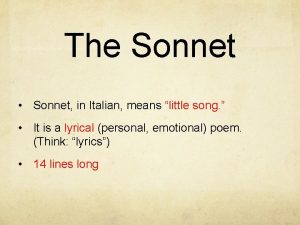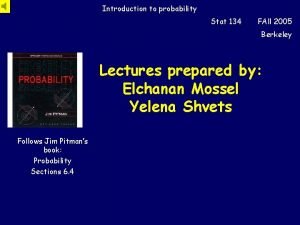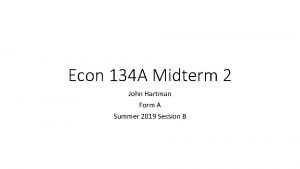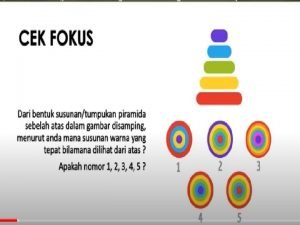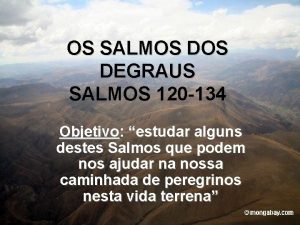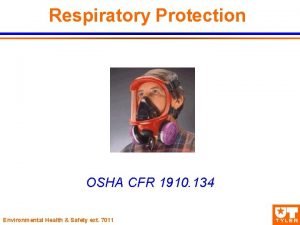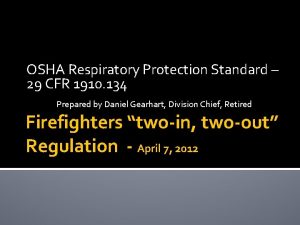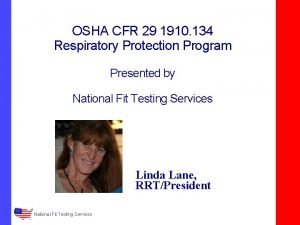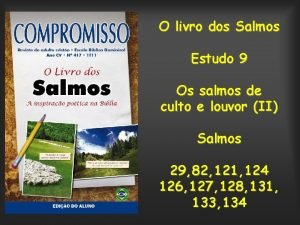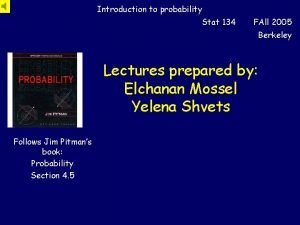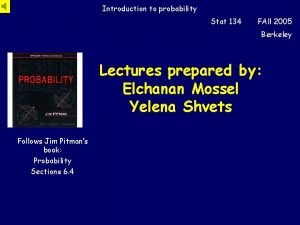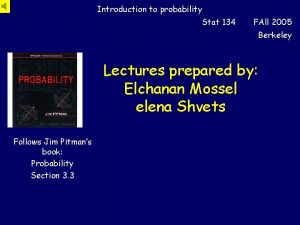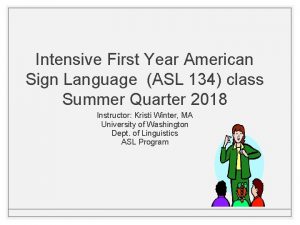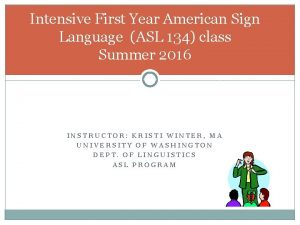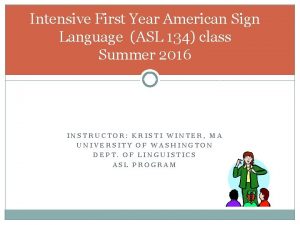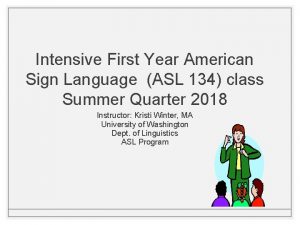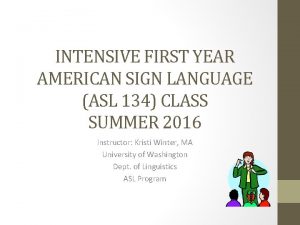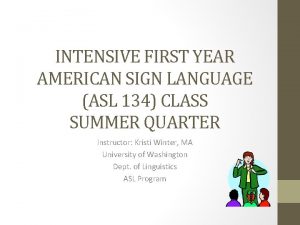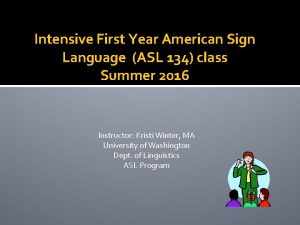Intensive First Year American Sign Language ASL 134










































- Slides: 42

Intensive First Year American Sign Language (ASL 134) class Summer Quarter Instructor: Kristi Winter, MA University of Washington Dept. of Linguistics ASL Program

Schedule: � Today: �SN Unit 5 “Talking about Activities” �Wednesday, July 18 th �Journal #2 (Hard copy) �SN Unit 5 �Signing Lunch (12: 45 pm – 1: 30 pm) �Thursday, July 19 th �SN Unit 5 �Video: “A Sign of Respect”

Unit 4 Talking about Family

Review: Family Vocabulary 1. 2. 3. 4. 5. 6. 7. 8. 9. 10. 11. 12. QUARREL NOT GET-ALONG SEPARATE DIVORCE STEP (or SECOND) FATHER fs-STEP DAUGHTER (SON) LOVE FADE-AWAY GO-SEPARATE-WAYS HALF BROTHER HALF SISTER ADOPT TAKE-CARE-OF

Homework 4: 11 Ten Years Later �Answers are on page 413

Review: Sexual Orientation 1. 2. 3. 4. 5. 6. 7. LGBTQ Lesbian Gay Bisexual Transgender Queer Straight

Homework 4: 12 �Answers are on page 414

Homework 4: 13 – David’s Keys (p. 207) 1. How many keys does David have altogether? � 11 keys 2. What are the keys for, and how many does he have for each purpose? 1. 2. 3. 4. 5. 6. 7. for his apartment – 3 keys for mailbox – 1 key bike lock – 1 key locker – 1 key workplace; front door and office – 2 keys for his and his wife’s cars – 2 keys he cannot remember – 1 key 3. Where did Iva find the keys? In the classroom 4. In what city does David lives? New York

Homework 4: 14 Commenting on Family Members �Minidialogue 1 1. What’s two comments does Stefanie make about Priscilla’s grandmother? �She’s pretty and looks young �How old is Priscilla’s grandmother? � 65 �How does Priscilla explain her grandmother’s youthful look? �Exercises; eats well; walks; has many friends. 1. To be like the grandmother, what do Priscilla and Stefanie both agree they should do? �Exercise.

Homework 4: 14 Commenting on Family Members �Minidialogue 2 1. Why can’t Iva pick out Melinda in the photo? � Melinda’s hair is different; it was 7 years ago. 2. What is the story behind the good-looking guy in the photo? � He was Melinda’s old boyfriend. They broke up when Melinda met someone else in college. 3. Is Melinda married now? Explain. � Engaged to marry next May. 4. What does Iva need to do now? � Save money to travel to Mexico for Melinda’s wedding. 5. What does Melinda suggest Iva take with her to Mexico? � Her bathing suit.

Homework 4: 14 Commenting on Family Members �Minidialogue 3 1. When and where was the photo taken? � One year ago at Cinnie’s aunt’s house. 2. What was the occasion? � Her aunt’s 75 th birthday. 3. The photo consists of. . ? � Cinnie’s family – her five children and their spouses; 4 grandchildren 4. Which child does Joey think looks like Cinnie? In what ways? � Her daughter; their smiles. 5. Does Joey have any grandchildren? � No.

Lesson 4: 14 Commenting on Family Members

Occasions

Making Comments a. c 2. f. b. d. c 1. e. g. h.

Share your family pictures. For each person tell: • how the person is related to you • person’s ranking if appropriate • the person’s marital status Others ask follow up questions such as: • person’s age • place of person’s residence and/or work • where and when the picture was taken • the occasion of the picture (ask yes/no question) Make comments about the person and/or the family.

Responsibility of Group Members The Signer: • Position yourself so others can see you The Listeners: • When sitting between a signer and another person, be aware of the other’s ability to see the signer and voluntarily move back • When sitting at the end, inform others you can’t see the signer

My Family Tree

Unit 5 “Talking about Activities”

Lesson 5: 1 Talking about Everyday Activities

July 2018 Sun Mon Tues Wed Thurs Fri Sat 1 2 3 4 5 6 7 8 9 10 11 12 13 14 15 16 17 18 19 20 21 22 23 24 25 26 27 28 29 30 31

Asking WHEN Questions �ASL structure: YOU _______ WHEN? (activity)

�Asking “when” questions My Week 1 Sun Mon Tues Wed Thurs Fri (today) Signer A: Ask when B did/will do a certain activity Signer B: Tell when Sat

�asking “do” questions My Week 2 Sun Mon Tues Wed Thurs (today) Signer A: Ask what B did/will do on a certain day Signer B: Tell the activity Fri Sat

Exercise 5: 1 – Lisa’s Week (student workbook, pages 389)

Exercise 5: 2 – Joy’s Week (student workbook, pages 390)

Lesson 5: 2 Agreement Verbs �GIVE-TO �SHOW-TO �THROW-TO �TAKE-FROM �ASK-TO �TELL-TO �Agreement Verbs - a verb that indicates the subject (the person doing the action) and the object (the person receiving the action) in its movement. Usually the verb moves from the subject towards the object. (p. 241)

Making Verbs Agree �Practice GIVE-TO, SHOW-TO, and THROW-TO �ASK-TO and TELL-TO

Making Verbs Agree in Narratives �Translation: One day after school, a little girl went home. As soon as she got into the house, she looked for her mother. Then she saw her mother and said to her: 1. Girl: (hiding something behind her back) I have a surprise for you! 2. Mom: Oh? What is it? Tell me. 3. Girl: I can’t tell you. It’s a surprise! 4. Mom: Show me? 5. Girl: hmmmm…Okay! (she hands her a bouquet of flowers) 6. Mom: Flowers! How nice! Thank you.

Lesson 5: 3 Words with Letters G and H �Fingerspelling: Words with Letters G and H Grace Gayle Doug Holly Hope Philip

Lesson 5: 4 Talking about Chores

Chores 1

Chores 2

Lesson 5: 4 Designating Locations for Non-Present People �Key Grammar (pp. 245 -247) � Designating locations for non-present people � If you want to talk about more than two non-present people, who are not in any rank order, you designate a location for each person along a horizontal arc in front of you starting on your non-dominant side. � When discussing each person, � be sure to orient signs toward the designated location when discussing that person, i. e. their chores � be sure the personal pronouns and possessive adjectives agree with the location when talking about the person � � � One other person Two other people Three other people

Rate how you feel doing the chore

Signer A: Ask who B lives with B: Tell who A: Ask what each person’s household chores are B: Name (up to 3) chores for each person (spatial agreement) • one other person • two other people • three other people or more A: Ask if B doesn’t mind doing his or her chores (specify which chore) B: Give opinion A: Respond

Lesson 5: 5 Asking if Done �Signer A: Ask if B is done with the chore �Signer B: Affirm or negate �ASL signs: 1. FINISH 2. NOT-YET

Do Exercise 5: 3 – Are You Done…? �Student Workbook, page 391

Lesson 5: 6 Talking about Errands

Errands 1 1. 2. 3. 4. 5. 6.

Errands 2 1. 4. 2. 5. 3. 6.

Homework for next class day: �Do homework 5: 1 -5: 5 �Journal #2 due on Wednesday, July 18 th (Hard copy)

Sources: �Smith, C. , Lentz, E. & Mikos, K. (1988)Signing Naturally Student Workbook Level 1. Dawn. Sign. Press. San Diego, CA �Smith, C. , Lentz, E. , Mikos, K. (2008) Signing Naturally Units 1 -6. Dawn Sign Press. San Diego, CA. �Zinza, Jason E. (2006) Master ASL! Sign Media, Inc. Burtonsville, MD. �Eastman, G. (1989) From Mime to Sign. T. J. Publishers, Inc. Silver Spring, MD. �Pictures from Microsoft Clip Arts
 No talking signs
No talking signs Sign sign everywhere a sign
Sign sign everywhere a sign Through your child's eyes
Through your child's eyes Signing naturally names and tidbits answers
Signing naturally names and tidbits answers Parameters asl
Parameters asl Asl sign portugal
Asl sign portugal Fingerseek
Fingerseek Sport in asl
Sport in asl Chores asl
Chores asl Orientation asl
Orientation asl What is an initialized sign in asl
What is an initialized sign in asl Trousseau's
Trousseau's What is trousseau sign
What is trousseau sign 2na + glucose/18
2na + glucose/18 Kernig and brudzinski signs
Kernig and brudzinski signs When the signs are the same and keep the sign
When the signs are the same and keep the sign Symbol for ordinary time
Symbol for ordinary time Leaving primary school poems
Leaving primary school poems Difference of first language and second language
Difference of first language and second language Difference of first language and second language
Difference of first language and second language Trima kasih ya tuhanku
Trima kasih ya tuhanku Hbu 131 uitm
Hbu 131 uitm Stat 134 berkeley
Stat 134 berkeley Ctb art 134
Ctb art 134 Ra no. 5250
Ra no. 5250 A sample of neon gas occupies a volume of 677 ml at 134 kpa
A sample of neon gas occupies a volume of 677 ml at 134 kpa Italian word sonneto which means little song.
Italian word sonneto which means little song. Osha 1910 134
Osha 1910 134 Stats 134
Stats 134 Econ 134
Econ 134 Hasil dari 108 + 132 dikurang 134 adalah
Hasil dari 108 + 132 dikurang 134 adalah 1910 134
1910 134 Salmos 120 a 134
Salmos 120 a 134 Osha 1910 respiratory protection
Osha 1910 respiratory protection Optisanitas
Optisanitas 1910 134
1910 134 Osha 1910-134
Osha 1910-134 Osha 1910 respirator
Osha 1910 respirator Salmo 124 estudo
Salmo 124 estudo Stat 134
Stat 134 Stat 134
Stat 134 134/141
134/141 Stat 134 berkeley
Stat 134 berkeley
